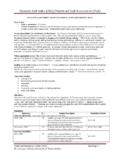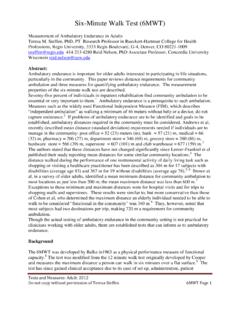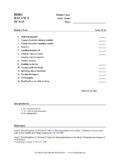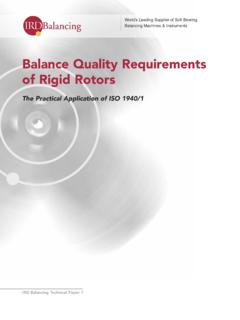Transcription of ACTIVITIES-SPECIFIC BALANCE CONFIDENCE (ABC) …
1 ACTIVITIES-SPECIFIC BALANCE CONFIDENCE (ABC) SCALE Test and Measures: Adult 2012 Do not copy without permission of Teresa Steffen ABC Page 1 Type of test: Time to administer: 5-10 minutes to administer. Clinical Comments: This test, along with a functional BALANCE test, such as the Berg, will tell the clinician if their client is over confident or under confident about falling. Purpose/population for which tool was developed: The ABC is one of several tools designed to measure an individual s CONFIDENCE in his/her ability to perform daily activities without falling. These tools were designed for use with older adults. The ABC was designed to include a wider continuum of activity difficulty and more detailed item descriptors than the Falls Efficacy Scale (FES) (see Appendix 2)1 Fear of falling is important to assess because it is a likely confound in measuring postural performance.
2 Deterioration in BALANCE may result from activity restriction mediated by the fear of When appropriate to use: Asking a yes/no question on fear of falling ( , are you fearful of falling?) may indicate when the full scale should be used. This may work better for females than The internal consistency does not decrease appreciably with the deletion of a few items; (12 of 16 are necessary). If fewer items are used, compute a total score by dividing by the number of items answered. Scaling: Ordinal. Scale has 16 items (score 0-1600 possible). The score is recorded as a percentage (%), with 100% the highest level of CONFIDENCE . Max score of 1600 divided by 16 items = 100% Equipment needed: Questionnaire (Appendix 1) and pencil Directions: See appendix 1.
3 The authors do not state what to do if the client says that it is an activity they never do. The questions are arranged in a hierarchical order yet this may not be true for all clients. Reliability: The ABC demonstrates a high level of internal consistency. Reference N= Sample Description Reliability Statistic Internal Consistency: (how the items in the scale relate to each other and to the group of items as a whole). Reliability statistic= Chronbach s alpha ( ) Powell, 19951 60 Seniors living at home over 65 years old. = .96 Steffen, 20053 87 community-dwelling seniors .93 Huang, 20094 168 Community dwelling, less frail , >60 in Taiwan Baseline: 8 weeks: Talley, 20085 213 Older woman at risk of falling at baseline and 12 weeks Salbach, 20066 51 People with stroke ABC-French Canadian version =.
4 94 .93 Cattaneo, 20077 20 Multiple Sclerosis Peretz, 20068 157 Parkinson s patients and patients with high level gait disorders (HLGD) with ABC scale and modified ABC-6 scale; HLGD N=70, controls N=68, PD N=19. ABC-HLGD = .90 ABC-Control = .83 ABC-PD = .91 ABC 6-HLGD = .81 ABC 6-Contol = .86 ABC 6-PD = .90 ACTIVITIES-SPECIFIC BALANCE CONFIDENCE (ABC) SCALE Test and Measures: Adult 2012 Do not copy without permission of Teresa Steffen ABC Page 2 Test Retest Reliability: Test retest reliability varied with the ABC from to The MDC was more divergent with the highest MDC = 38% change and the lowest was 13%. Reference Population N X [SD] (time one) Time Between Testing Test/Retest Reliability MDC95 Holbein-Jenny, 20059 Personal care home residents; Age Range74-92 26 1-2 weeks ICC (1,1) = Miller, 200310 Patients from outpatient clinic 50 4 weeks ICC (3,1) = Parry, 2001 (UK ABC)11 Consecutive, ambulant, new, and return patients (n=119) and their friends and relatives (n=74) 39 1 week ICC = Powell, 19951 Steffen,200812 Cattaneo, 20077 Community dwelling older adults; Age: 65-95 Community dwelling adults with Parkinsonism Multiple Sclerosis 21 36 20 70(19) 57(25) 2 weeks.
5 1 week 3 days r = ; ICC(2,1)= ICC(2,1) = 13% 20% Validity: Although there often is no gold standard to measure the ABC against, the ABC is correlated with other self-administered tests and demonstrates Bandura s work on self-efficacy that perceived capability rather than actual physical ability is more predictive of behavior in a given domain . Clinical application of this would include working on the patient s CONFIDENCE in their BALANCE as well as objective BALANCE activities . Construct / Concurrent Validity: It is difficult to always differentiate between these 2 types of validity. Evaluating this property requires a gold standard measure with which to compare the tests results.
6 Such a gold standard is often not available. Population N = Support for Validity Young and older women 34 Young Unimpaired =12 Older Unimpaired = 12 Older Impaired = 10 Correlations between ABC and maximal strength (.75), rapid step test ( ).13 Seniors over 65 60 ABC is correlated with FES ( ), Physical Self-Efficacy Scale Scores (.49), PANAS scale (.12)1, walking speed (.56) and FES ( ).2 Pts with hip fx 56 There is no correlation between changes in FIM scores and change in ABC scores for 56 patients in a specialized rehabilitation The Falls-Efficacy Scale (FES) and ABC were not correlated in this population. Pts in a BALANCE and vestibular clinic 71 Correlation between dizziness handicap inventory (DHI) and ABC (age 26-88) was Mild BALANCE impairment 177 184 ABC correlated with tandem stance time, unipedal stance time, tandem walking, TUG, 6 MWT, Tinneti s Performance Oriented Mobility Assessment (.)
7 16 Patients with stooping, crouching, and kneeling (SCK) difficulties, characteristics associated with SCK included ABC Scale score. (OR= ; 95% CI, ).17 Community dwelling elderly 50 ABC correlated with BBS (.75) and TUG (.70).18 (Mean age = 82) ACTIVITIES-SPECIFIC BALANCE CONFIDENCE (ABC) SCALE Test and Measures: Adult 2012 Do not copy without permission of Teresa Steffen ABC Page 3 Vestibular dysfunction 137 32 ABC with DGI = .58. This relationship increases for those with mild to moderate vestibular weakness and decreases for those with severe or total vestibular (Mean age = 61) ABC not correlated with Four Square Step Test (FSST)20 4-month follow-up of hip fx pts.
8 73 ABC correlated with BBS (.77), FES (.68), Gait Speed (.65), Modified Barthel (.67).21 Community dwelling women 65-75 yrs of age 140 ABC with Simple & Complex walking while talking test (WWT) ( & )22 Community swelling >60 yr old seniors in Taiwan 168 ABC with FES baseline/8weeks (.88/.89) Geriatric Rear of falling (GFFM) ( )4 Ambulatory adults with a wide range of BALANCE function first session n=12 second session n=11 ABC with BESTest (.685),Stability Limits/Verticality section ( )Anticipatory Postural Adjustments section( )23 Patients with Fibromyalgia 34 ABC with BESTest = , Fibromyalgia Impact Questionnaire (FIQ) severity , fatigue ( ), stiffness( ), physical impairment( ), pain( ), anxiety ( ) and depression ( )24 Older adults living in retirement villages 167 ABC with Tandem stance ( ), one leg stance ( ), TUG ( )25 Older woman at risk of falling 213 ABC with survey of activities and Fear of Falling in the Elderly (SAFE) ( ), age ( ), BBS ( ), gait speed ( ), TUG( ), # Act.
9 Restrictions ( ), geriatric depression scale ( ), fall history ( ), # Medical Conditions ( ), Assistive device use( ), 8 subscales of the SF-36 (. ). No correlation with ABC and outdoor Patients with stroke 25 ABC with DGI ( ), BBS (.83)26 Community dwelling seniors 63 91 ABC with Reintegration to Normal Living (RNL) Index, ( )27 ABC with Ambulatory Self- CONFIDENCE Questionnaire (ASCQ) ( )28 Subjects with Multiple Sclerosis (MS) 51 ABC with BBS( ), DGI ( ), TUG ( ), DI( ), and DHI ( )29 The instrument went through three phases in its development. Therapists (15) and clients receiving therapy (12) gave input, then 60 seniors went through structured interviews, and finally 21 subjects were administered the ABC scale and BALANCE Bandura s work on self-efficacy suggests that perceived capability rather than actual physical ability is more predictive of behavior in a given domain2,30 Predictive Validity: The cut off for high CONFIDENCE is generally >80%, with a cutoff of <67% for a Fear of Falling.
10 Population N Results Senior Living Facility 287 Using regression and ABC scores as the dependent variable; depression, use of walking aid, slow gait speed and race were independent variables that were significant 31. Individuals with ABC scores less than 50% were times more likely to be depressed, were times more likely to walk slower than .9m/s, were times more likely to use a walking aid and were times more likely to show impaired gait/ BALANCE than individuals with ABC scores greater than 50%.31 Seniors over 65 60 278 There was no significant difference on ABC scores for people who fell versus people who did not fall, with a cutoff score = ABC DGI.( )32 Scores were lower for women than men on total score and stair climbing ACTIVITIES-SPECIFIC BALANCE CONFIDENCE (ABC) SCALE Test and Measures.









